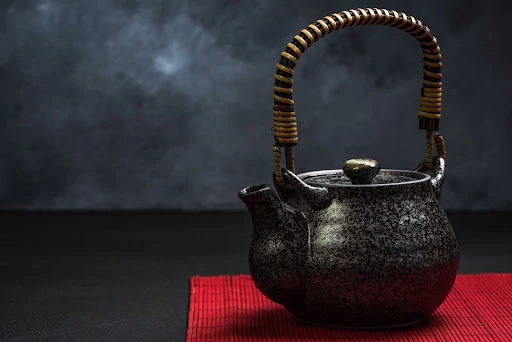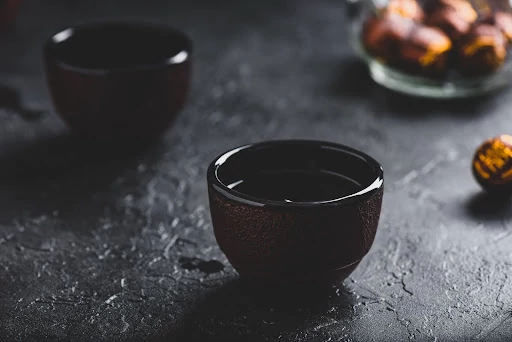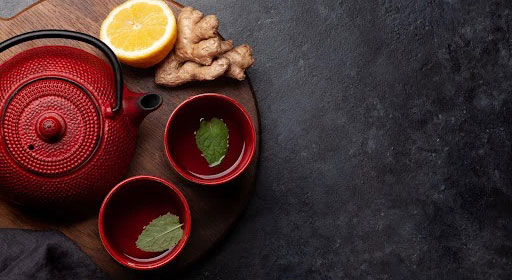Red teas occupy a large layer of the Chinese tea assortment. It was in China that it appeared and began its development by species and varieties. Although red tea can be found in India and Ceylon. It is unusual and individual in everything: appearance, aroma, taste.
In this article, we will analyze what Chinese red tea is, where its name comes from, what it is made of, what types are and what this drink looks like.
Red tea has occurred as a result of changed parameters of the black production process.
It is generally accepted that it primarily appeared as a result of a violation of green tea production technology. Either the weather influenced the fermentation process, or the craftsmen could not stop it in time, but as a result, the tea leaves turned brown, and tea specialists dried the tea leaves, in which the fermentation process reached 60-80% over pine wood.
As a result of saving tea raw materials, a new type of tea appeared & ndash; black, with a characteristic woody aroma.
Tea technologies, experimenting with the production of black tea, making changes in technological parameters, have developed a technology for making red tea.
Recently, China has a rich and diverse assortment.
The history of development is relatively young and has no more than half a century.
For the production of red tea, raw materials are collected for 8 months (almost year-round):
- Spring and summer crops are characterized by the lightness and softness of flower taste.
- Autumn has a richer dense taste and a fruity floral aroma.
Differences from other varieties
There are teas in China that are similar to red. Some have a dark appearance, because of this it is confused with black Chinese tea or it is compared with duck tea, the bright representative of which is Da Hong Pao tea.
The red color of the tea leaf is similar in these types of tea, but if you look closely, you can still find some differences. The first difference between these teas from each other & ndash; it is the scent of a dry tea leaf. Black tea has a woody-pine aroma, it has little sweetness and floweriness, which is present in the aroma of cliffhangers or a thick sugary-sweet aroma, like red.
The color of the tea leaf also differs: in red tea there are types in different proportions, sometimes in appearance & ndash; these are golden yellow twisted teapots of various shapes.
Black Chinese tea in the composition may contain types, but their content is not more than 2-5%.
Cliff Uluns do not contain types. Oolong tea raw materials have shades from brown with a greenish tint to dark brown. It is the uneven coloration of the leaf that gives the floral aroma of a dry leaf.
Twisting is usually medium, plate-like prevails. Differences are not limited to appearance. If you brew these teas, you will feel the difference in taste too.
Black tea has a special calm wood-pine aroma, sometimes you can feel nutty, smoked or charcoal. The taste is a little simple, watery, but there is a certain viscosity, oiliness in the taste, which leaves a short aftertaste.

Oolong in most of their diversity have floral notes, sometimes fruit or nutmeg. They are soft, fragrant, without bitterness and strong astringency.
Red tea & ndash; these are tea-making masterpieces.
It is special, beautiful, unique. The aroma is rich in rich tart, thick honey or dried fruit notes.
The color of the brewed drink is honey orange, bright, transparent, very attractive. The taste is rich. You feel nutty, honey, fruity or chocolate, sweet notes that linger in the honey finish.
This tea is not as light as oolong, but it is very organic and balanced.
His & laquo; sustained & raquo; dense taste does not give the severity of the perception of the drink. Red tea as aged wine & ndash; exotic and unusual.
Manufacturing differences
And, of course, technological processes have differences. The difference is in the quality of the tea leaf that is assembled, and in the special conditions of the technology, although all stages of production are identical:
- Wilting is carried out on large trays or on special bedding in the open air for 4 hours, and then the tea leaf is transferred to a closed room for 2-3 hours for cooling, while the raw materials are periodically mixed.
- & laquo; Killing greenery & raquo; & ndash; an important process that takes place at a temperature of 150-180 & deg; C in special installations (furnaces) for no more than 10 minutes.
- Twist & ndash; fermentation takes place even warm leaf in rollers in several stages. After twisting, tea raw materials are sorted into fractions (if necessary). This is followed by repeated fermentation. To do this, the sheet is left for several hours in a well-ventilated room with high humidity. This stage is the main and very important in production. Depending on the duration, temperature and humidity, you can get teas completely different in taste.
Last & ndash; drying and roasting. When the fermentation process reaches the required level, the leaves are slowly dried or fried at a temperature of 60-80 & deg; C, then it is necessary to abruptly stop the drying process so that the leaves do not burn.

What red tea looks like
It is usually divided into Gong Fu & ndash; tea of the highest skill, pressed and crushed. For production, the first three leaves and a kidney are collected. Such a collection gives a high-quality, very fragrant tea, while you cannot call it tart or rich.
Red teas have a characteristic sweetness in the aftertaste and a full, enveloping taste. It is easily recognizable by the black color of the tea leaf and the red-brown color of the drink.
Very often red teas contain a large number of types. The more types, the more aromatic tea you get.
Visually, it is very difficult to confuse red tea with another. It is beautiful and unusual, has a wide variety in appearance, in the form of a twist. We may come across red tea in the form of thin twisted strings, as thin as a hair, as flat long buds, spirally twisted in the form of & laquo; snails & raquo;. All these teas have an incomparable aroma and a rich full, thick taste.
The quality of red tea directly depends on the raw materials used in the collection. Fresh, thin leaves give a soft, fragrant brew.
The larger the tea leaf, the deeper the aroma you get. It becomes calmer and fuller to taste. Red teas have a bright rich aroma and taste.
You can recognize honey, nutmeg or dried fruit notes in the aroma, sometimes tea has a bread aroma. The taste is very mild, but it has a long fragrant sweet aftertaste.

Ways to brew red tea
1. Chinese, Spill Method . On average, depending on the variety, it can withstand from 3 to 6 infusions.
It is better to use clay custard kettles for brewing. Clay & ndash; material that remembers, it is able to preserve the aroma of brewed tea. The inner surface of the kettle is filled with the aroma of red tea, which remains for a long time. With each new brew, the aroma filling becomes more saturated.
Remember to warm up your brewing utensils & ndash; fill the kettle with boiling water, hold for 30 seconds and drain. Now your kettle is ready. The tea leaf, which was placed in the kettle, begins to soften and become elastic under the influence of heat and moisture.
To get delicious aromatic tea, you need to take 5-7 grams of tea per 200 ml. The first brew lasts from 30 seconds to 45 minutes. Then you need to increase the brewing time for every 10-20 seconds. The softer the raw materials, the faster they brew and the less time you need.
2. Classic European . It is more suitable for brokered tea, but loose tea is also brewed.
With the classic European brewing method, you can take a glass, ceramic or clay kettle. Warm up the dishes, prepare them for work.
Add 5-7 grams of tea per 350 ml of water. Brewing time 5 minutes
Broiled tea may be re-brewed, but no more than 1 times. Water in both cases should be 90 & deg; C.

Use and storage
Red tea can be drunk with milk, lemon, but the most unusual way & ndash; it's red tea and coffee.
Tea drink is brewed by method of slow pouring of brew through sieve. Coffee is brewed separately in a coffee pot. The coffee is then added to 50:50 tea. Choose the ratio of tea and coffee individually, depending on the type of coffee. In addition to such a drink, cream is added for taste.
Tea storage & ndash; an important stage. Tea does not like bright light, temperature changes.
It should not dry out, so storage in sealed containers (tin glass, porcelain, ceramic jars) will extend & laquo; life & raquo;.
Take the jar away from direct sunlight, put it in a dark, dry place and after a while you will make sure that your brewed tea remains just as fragrant and rich in taste.
Red tea can last up to 2 years.
What red tea contains
It has a high content of oxidized polyphenols, less extractive substances, but it contains a large amount of thein, which, when brewed, turns into an infusion.
Thein improves blood supply in the body, relieves vascular spasms, strengthens the walls and increases their elasticity, increases the intensity of the heart.
Red tea tones, invigorates and relieves fatigue and mental stress well. It is recommended for people with low blood pressure and tone. Red teas are not recommended for easily excitable toned people.
Tea increases performance and can reduce the body's need for sleep and rest. It lowers blood sugar and is therefore recommended for regular use in diabetes.
Red tea has a warming effect, so it is best not to drink it at night.
Variety

Assortment of red teas & laquo; Russian Tea Company & raquo; diverse, it attracts with the special beauty of its appearance, the honey-red infusion of the drink and a deep, thick, but at the same time soft, sometimes fruity aroma.
We offer a variety of quality red teas ranging from simple to high-end, but each has its own characteristics.
- Golden Yunnan & nbsp; & ndash; tea, with which we recommend starting the acquaintance with red teas. This tea & ndash; one of simple and calm. It has a fruity aroma and a soft, sweet taste.
Usually, in appearance, Golden Yunnan & ndash; it is a cut, insufficiently twisted, flat-leaf tea. The infusion is bright, brown. Taste & ndash; tart, dense, with a slight bitterness. - Another red tea we recommend & ndash; it is & nbsp; & laquo; Golden Monkey & raquo; & nbsp; & ndash; Dian Hong TGFOP. Red tea of the Chinese province of Yunnan, which is famous for its various types of red teas. This tea will surprise you with the appearance of light brown leaf buds.
The drink has a delicate, floral aroma, like summer meadow flowers. And the taste is very diverse: juicy, spicy, sweet, dense floral and fruit, sometimes with notes of pepper, cinnamon, nutmeg. - Golden Snail . Luxurious red Chinese tea is twisted into tight, slightly plate spirals. Its peculiarity is a pronounced, pleasant, fruity aroma and a soft, dense, tart taste, with floral shades and an aftertaste.
The drink has an amber, reddish color of the infusion. You can feel malt, honey, caramel, chocolate shades in the aroma. The taste is juicy, spicy, sweet, enveloping, with a long lasting aftertaste of chocolate and spices. - Jin Jun Mei . This tea belongs to one of the youngest red teas. Its production began no more than 20 years ago. This is the highest quality tea. Its appearance & ndash; these are thin highly twisted tea leaves that are mixed with the same twisted types.
For its production, they take a small young tea leaf & ndash; in order for tea leaves to be no more than 3 cm long when dry. This tea is very fragrant even when dry. Its rich sweetness immediately attracts attention. When brewing, a small amount of dry tea leaf is enough for it to reveal all its richness of taste and aroma. The drink has a soft, pleasant, spicy-honey aroma, as well as a rich, malt-fruit taste. A soft dried fruit, dense and thick taste with medium astringency gradually goes into a sweetly spicy aftertaste. A very unusual and amazing tea.
Add color to your life along with an assortment of Chinese red teas from the Russian Tea Company. Feel the richness of this drink and you will not part with it.
